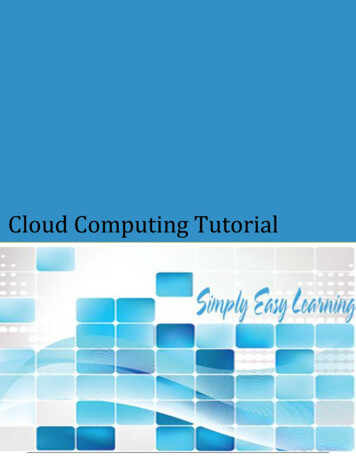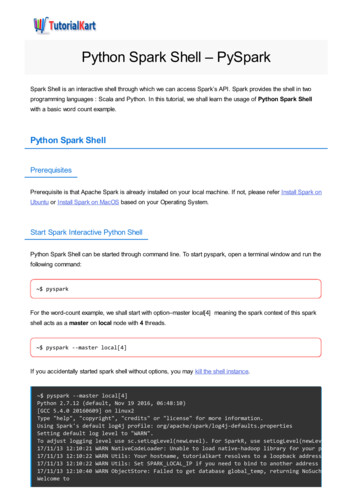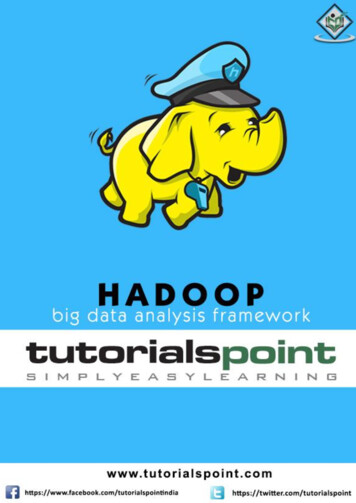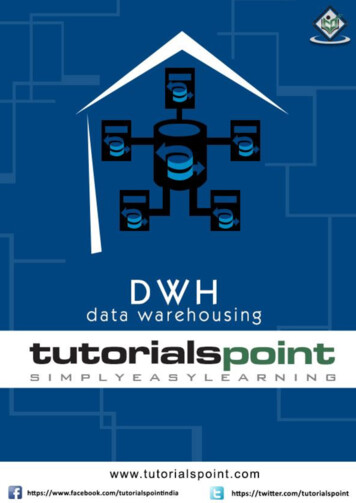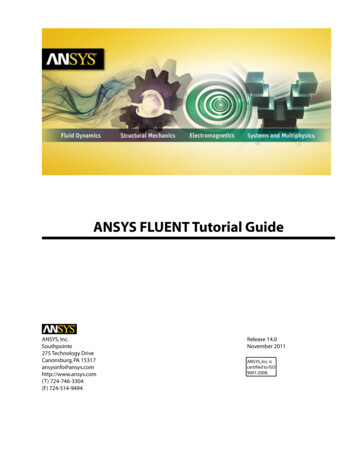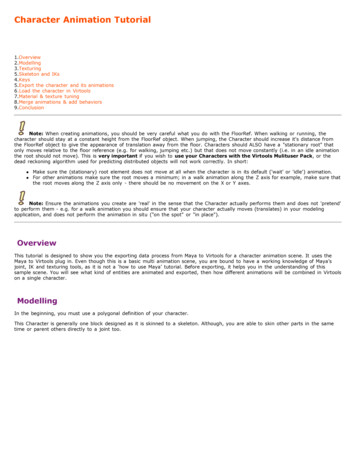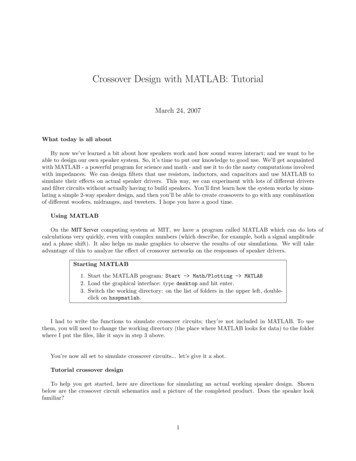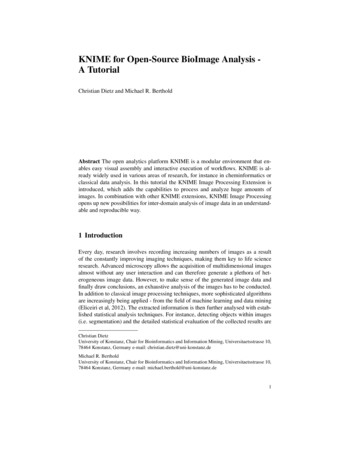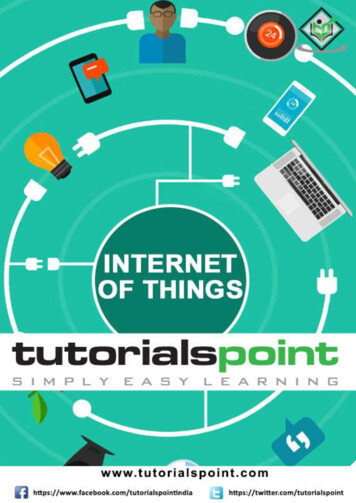
Transcription
Internet of ThingsAbout the TutorialIoT (Internet of Things) is an advanced automation and analytics system which exploitsnetworking, sensing, big data, and artificial intelligence technology to deliver complete systemsfor a product or service. These systems allow greater transparency, control, and performancewhen applied to any industry or system.IoT systems have applications across industries through their unique flexibility and ability to besuitable in any environment. They enhance data collection, automation, operations, and muchmore through smart devices and powerful enabling technology.This tutorial aims to provide you with a thorough introduction to IoT. It introduces the keyconcepts of IoT, necessary in using and deploying IoT systems.AudienceThis tutorial targets IT professionals, students, and management professionals who want a solidgrasp of essential IoT concepts. After completing this tutorial, you will achieve intermediateexpertise in IoT and a high level of comfort with IoT concepts and systems.PrerequisitesThis tutorial assumes general knowledge of networking, sensing, databases, programming, andrelated technology. It also assumes familiarity with business concepts and marketing.Copyright & Disclaimer Copyright 2016 by Tutorials Point (I) Pvt. Ltd.All the content and graphics published in this e-book are the property of Tutorials Point (I) Pvt.Ltd. The user of this e-book is prohibited to reuse, retain, copy, distribute or republish anycontents or a part of contents of this e-book in any manner without written consent of thepublisher.We strive to update the contents of our website and tutorials as timely and as precisely aspossible, however, the contents may contain inaccuracies or errors. Tutorials Point (I) Pvt. Ltd.provides no guarantee regarding the accuracy, timeliness or completeness of our website or itscontents including this tutorial. If you discover any errors on our website or in this tutorial,please notify us at contact@tutorialspoint.comi
Internet of ThingsTable of ContentsAbout the Tutorial . iAudience . iPrerequisites . iCopyright & Disclaimer . iTable of Contents . ii1.IOT OVERVIEW . 1IoT Key Features . 1IoT Advantages . 1IoT Disadvantages . 22.IOT HARDWARE. 3IoT Sensors . 3Wearable Electronics . 4Standard Devices . 53.IOT SOFTWARE . 64.IOT TECHNOLOGY AND PROTOCOLS . 75.IOT COMMON USES . 8Engineering, Industry, and Infrastructure . 8Government and Safety . 8Home and Office . 8Health and Medicine . 96.IOT MEDIA, MARKETING, & ADVERTISING . 107.IOT ENVIRONMENTAL MONITORING. 12ii
Internet of Things8.IOT MANUFACTURING APPLICATIONS. 149.IOT ENERGY APPLICATIONS . 1610.IOT HEALTHCARE APPLICATIONS . 1811.IOT BUILDING/HOUSING APPLICATIONS. 2012.IOT TRANSPORTATION APPLICATIONS. 2213.IOT EDUCATION APPLICATIONS . 2414.IOT GOVERNMENT APPLICATIONS . 2615.IOT LAW ENFORCEMENT APPLICATIONS . 2816.IOT CONSUMER APPLICATIONS . 3017.IOT THINGWORX . 3218.IOT CISCO VIRTUALIZED PACKET CORE . 3519.IOT SALESFORCE. 3720.IOT GE PREDIX . 3821.IOT ECLIPSE IOT . 4022.IOT CONTIKI. 4223.IOT SECURITY . 4424.IOT IDENTITY PROTECTION . 4625.IOT LIABILITY . 4726.IOT USEFUL RESOURCES . 49iii
1. IoT OverviewInternet of ThingsIoT systems allow users to achieve deeper automation, analysis, and integration within a system.They improve the reach of these areas and their accuracy. IoT utilizes existing and emergingtechnology for sensing, networking, and robotics.IoT exploits recent advances in software, falling hardware prices, and modern attitudes towardstechnology. Its new and advanced elements bring major changes in the delivery of products,goods, and services; and the social, economic, and political impact of those changes.IoT Key FeaturesThe most important features of IoT include artificial intelligence, connectivity, sensors, activeengagement, and small device use. A brief review of these features is given below: AI – IoT essentially makes virtually anything “smart”, meaning it enhances every aspectof life with the power of data collection, artificial intelligence algorithms, and networks.This can mean something as simple as enhancing your refrigerator and cabinets to detectwhen milk and your favorite cereal run low, and to then place an order with your preferredgrocer. Connectivity – New enabling technologies for networking, and specifically IoTnetworking, mean networks are no longer exclusively tied to major providers. Networkscan exist on a much smaller and cheaper scale while still being practical. IoT createsthese small networks between its system devices. Sensors – IoT loses its distinction without sensors. They act as defining instrumentswhich transform IoT from a standard passive network of devices into an active systemcapable of real-world integration. Active Engagement – Much of today's interaction with connected technology happensthrough passive engagement. IoT introduces a new paradigm for active content, product,or service engagement. Small Devices – Devices, as predicted, have become smaller, cheaper, and morepowerful over time. IoT exploits purpose-built small devices to deliver its precision,scalability, and versatility.IoT AdvantagesThe advantages of IoT span across every area of lifestyle and business. Here is a list of some ofthe advantages that IoT has to offer: Improved Customer Engagement – Current analytics suffer from blind-spots andsignificant flaws in accuracy; and as noted, engagement remains passive. IoT completelytransforms this to achieve richer and more effective engagement with audiences. Technology Optimization – The same technologies and data which improve thecustomer experience also improve device use, and aid in more potent improvements totechnology. IoT unlocks a world of critical functional and field data.1
Internet of Things Reduced Waste – IoT makes areas of improvement clear. Current analytics give ussuperficial insight, but IoT provides real-world information leading to more effectivemanagement of resources. Enhanced Data Collection – Modern data collection suffers from its limitations and itsdesign for passive use. IoT breaks it out of those spaces, and places it exactly wherehumans really want to go to analyze our world. It allows an accurate picture of everything.IoT DisadvantagesThough IoT delivers an impressive set of benefits, it also presents a significant set of challenges.Here is a list of some its major issues: Security – IoT creates an ecosystem of constantly connected devices communicatingover networks. The system offers little control despite any security measures. This leavesusers exposed to various kinds of attackers. Privacy – The sophistication of IoT provides substantial personal data in extreme detailwithout the user's active participation. Complexity – Some find IoT systems complicated in terms of design, deployment, andmaintenance given their use of multiple technologies and a large set of new enablingtechnologies. Flexibility – Many are concerned about the flexibility of an IoT system to integrate easilywith another. They worry about finding themselves with several conflicting or lockedsystems. Compliance – IoT, like any other technology in the realm of business, must comply withregulations. Its complexity makes the issue of compliance seem incredibly challengingwhen many consider standard software compliance a battle.2
2. IoT HardwareInternet of ThingsThe hardware utilized in IoT systems includes devices for a remote dashboard, devices forcontrol, servers, a routing or bridge device, and sensors. These devices manage key tasks andfunctions such as system activation, action specifications, security, communication, anddetection to support-specific goals and actions.IoT SensorsThe most important hardware in IoT might be its sensors. These devices consist of energymodules, power management modules, RF modules, and sensing modules. RF modules managecommunications through their signal processing, WiFi, ZigBee, Bluetooth, radio transceiver,duplexer, and BAW.The sensing module manages sensing through assorted active and passive measurementdevices. Here is a list of some of the measurement devices used in IoT:Devicesaccelerometerstemperature sensorsmagnetometersproximity sensorsgyroscopesimage sensorsacoustic sensorslight sensorspressure sensorsgas RFID sensorshumidity sensorsmicro flow sensors3
Internet of ThingsWearable ElectronicsWearable electronic devices are small devices worn on the head, neck, arms, torso, and feet.Smartwatches not only help us stay connected, but as a part of an IoTsystem, they allow access needed for improved productivity.Current smart wearable devices include: Head – Helmets, glasses Neck – Jewelry, collars Arm – Watches, wristbands, rings Torso – Clothing, backpacks Feet – Socks, shoes4
Internet of ThingsSmart glasses help us enjoy more of the media and services we value, andwhen part of an IoT system, they allow a new approach to productivity.Standard DevicesThe desktop, tablet, and cellphone remain integral parts of IoT as the command center andremotes. The desktop provides the user with the highest level of control over the system and itssettings. The tablet provides access to the key features of the system in a way
IoT (Internet of Things) is an advanced automation and analytics system which exploits networking, sensing, big data, and artificial intelligence technology to deliver complete systems for a
![Unreal Engine 4 Tutorial Blueprint Tutorial [1] Basic .](/img/5/ue4-blueprints-tutorial-2018.jpg)
